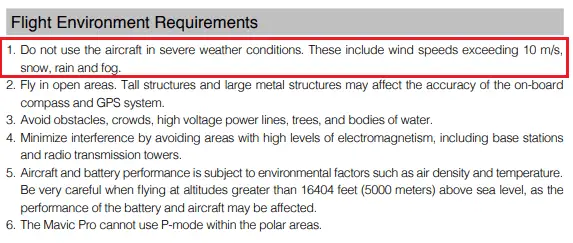
Imagine you’re flying your drone over a lake and all of a sudden you lose control. The drone begins to automatically descend, you jump in the lake in an attempt to get under it, but you fail. Splash, it hits the body of water. Will it float?
Standard drones such as the DJI Mavic can’t float on water because the casing of the drone isn’t watertight. As soon the drone lands on water, the water will begin to flow into the drone’s casing which will pull it underwater, unless your drone is designed to float, or if it has a flotation device.
Flotation devices are great pieces of equipment especially if you’re going to frequently fly your drone over a lot of water. Here are some flotation devices you can use for your drone.
How To Make Your Drone Float
There are a few ways that you can stop your drone from sinking like a brick if it does crash in the water. The most common ways involve attaching round styrofoam balls to the bottom of the drones landing gear, which can actually be extremely effective.
That being said, I’ve laid out some common flotation devices that can be bought online, however, if you have very little money to spend and you want to take a DIY approach, then think about how you can make the products below yourself.
WaterStrider for the DJI Phantom 2, 3, & 4.
The WaterStrider is specifically designed for the Phantom series and costs between $119-$139 depending on your Phantom drone. This unique piece of equipment doesn’t just make your drone float if you crash it in the water, but it actually allows you to willingly land in the water which is pretty awesome. It only takes around 5 minutes to assemble so installing it is relatively easy and quick.
The only downside is the weight. You’ll notice that your Phantom drone will struggle to take off and while it’s in the air, you’ll hear that the drone is working a bit harder to stay in the air. So when using this, make sure you take the weight into account when considering your flight time. The extra weight will drastically reduce the drones flight time.
Thekkiinngg Flotation Device for the Mavic 2 series.
This is a very simple solution designed for the Mavic 2 series that will only set you back around $26.99 on Amazon. It’s so simple that I don’t see any reason why you can’t make it on your own by cutting up a pool noodle.
The Thekkiinngg floatation device consists of four styrofoam balls that are simply attached to the landing gear of the Mavic 2 drone. So when you land your drone on water, these styrofoam balls will misplace water well enough to keep your drone floating. Because styrofoam is so light, it will have very little effect on the drones flight time and performance.
In the video above the drone pilot mentioned that “the drone flies like they aren’t even there.” The only downside was that if you fly the drone aggressively, the balls might appear on the camera.
Nesee Buoyancy Waterproof Ball for the Mavic Air.
This is a flotation solution designed specifically for the Mavic Air and only costs around $14. It’s very similar to the styrofoam balls for the Mavic 2 series, however, the only difference is that they are made from soft silicone.
The silicone is also very lightweight, which should affect flight time and performance only slightly.
GetterBack Drone Recovery Device
GetterBack isn’t really a flotation device, it’s more of a recovery system that will help you get your drone back if you do crash in the water. At $40 it is pretty expensive, however, it could save you a ton of money. Here’s how it works. The drone hits the water and begins to sink, once it reaches a depth of around 6 feet it deploys a flotation device that will help you pinpoint the location of your drone. Pretty cool huh?
Once you do retrieve your drone you will still have to try and save it from water damage, however, the quicker you find your drone underwater the more likely you’ll be able to save it. Even if the drone dies, at least you’ll still be able to salvage other valuable stuff off the drone, such as media devices, and potentially even the camera. So it’s definitely a worthy investment if you’re thinking of flying over water.
Is It Safe To Fly Your Drone Over Water?
This heavily depends on how much experience you have flying drones. If you’re a new drone pilot, then you should probably stay far away from any body of water, don’t even fly close to it. It’s very easy for a beginner to lose control, and with your luck, the one direction the drone decides to fly off will probably be a big old lake.
Avoid water as much as possible. Instead, train in an open area such as a public park, or sports field. Once you’re more comfortable flying the drone, then you can start getting some amazing footage over a lake or the ocean.
If you’re an experienced drone pilot then flying over water can be safe. However, even the most experienced drone pilots get their drones dunked by mistake. It’s not always the pilot that causes the drone to crash. At the end of the day, a drone is a machine and all machines malfunction sooner or later usually at the worst possible moment…like over a lake.
4 Drones That Do Float
If you’re still looking for a drone and you know you’ll be flying it over water, it could be a good idea to get a waterproof drone.
- SwellPro Splash Drone 3 Fisherman is a drone that was originally designed for fishing and will cost you around $1,199. It’s known for being the most waterproof drone and can actually be fully submerged.
- JJRC H31. This is more of a splash-proof drone that is very affordable at $$35 on amazon. So if you’re looking for a toy drone that can survive the rain, this is your best bet.
- PowerEgg X. This unique looking drone has floats that allow it to sit above the surface of the water. The body doesn’t have any extra resistance to water so if you need protection against rain, this isn’t really the best. For $899 on Amazon, it’s not a bad deal.
- QuadH2O. This is an “assemble your own drone kit” that has extra protection against waterproof. If you’re into DIY stuff then this could be the drone for you.
Are DJI Drones Water-resistant?
Before I dive into this, it’s important to know the definition of water-resistance. All that water-resistance means is that your electronic component has some kind of resistance to water.
ALL electronics are designed to have a level of resistance to water, so if you want a straight answer then yes, all DJI drones are water-resistant. However exactly how resistant are they to water? Well to know, you’ll have to either look in the drone’s manual or at the drones IP rating. This rating will tell you exactly what level of protection your drone has against water.
The drones manual should give you rough guidelines on how water-resistant your drone is. The below image shows an example of the DJI Mavics manual.

If you do want to better understand the drone’s resistance to water, you’ll have to find the drone’s IP rating, (International Protection Marking.) This “IP” number can usually be found on the drone itself or the manual, however, if you can’t find it there you’ll have to contact DJI customer support.
Once you’ve found it, the table below will show you how you can read it.
| Second Digit/Number: | Protected against: | Effective against: | Details of test: | Example: |
| X | – | – | This means that there is no data available. | IP3X |
| 0 | No protection. | Nothing. | No test. | IP30 |
| 1 | Dripping water. | Vertically water dripping onto the electronic device while rotating at 1 RPM. | Test was done for 10 minutes with 1mm rainfall per minute. | IP31 |
| 2 | Dripping water when tilted at 15° | Vertically dripping water while electronic object is tilted at 15°, Four positions were tested with two axis. | Total of 10 minutes performed, 20m30s for each direction. Used 3mm of rainfall per minute. | IP32 |
| 3 | Water spraying. | Water is falling at 60° from vertical as a spray. | Test lasted for 1 minute per square meter for a minimum of 5 minutes. Water volume is 10 litres per minute. | IP33 |
| 4 | Water splashing. | Water splashing from any direction. | Test lasted for at-least 10 minutes using a oscillating tube. | IP34 |
| 5 | Water jets. | Water jetted against an enclosure. | Test lasts at-least 3 minutes with 12.5 litres per minute. | IP35 |
| 6 | Powerful water jets. | Water jetted with more power against enclosure. | Test lasts at-least 3 minutes with 100 litres per minute. | IP36 |
| 6K | Powerful water jets with increased pressure. | Water jetted with even more power against enclosure. | Test lasts at-least 3 minutes with 75 litres per minute. | IP36K |
| 7 | Immersion, up to 1 meter (3 ft 3 in) depth. | Electronic device can be fully immersed under water up to 3 feet and 3 inches. | In the test the device was immersed for 30 minutes. | IP37 |
| 8 | Immersion, 1 meter (3 ft 3 in) or more depth. | Can be fully immersed for a longer period of time. Exact amount decided my manufacturer. | Tested for duration decided by manufacturer. | IP38 |
| 9K | Powerful high-temperature water jets. | Protected against high pressure and high temperature water. | Test lasts for a minimum of 3 minutes with water temperature of 80 °C (176 °F) | IP39K |
